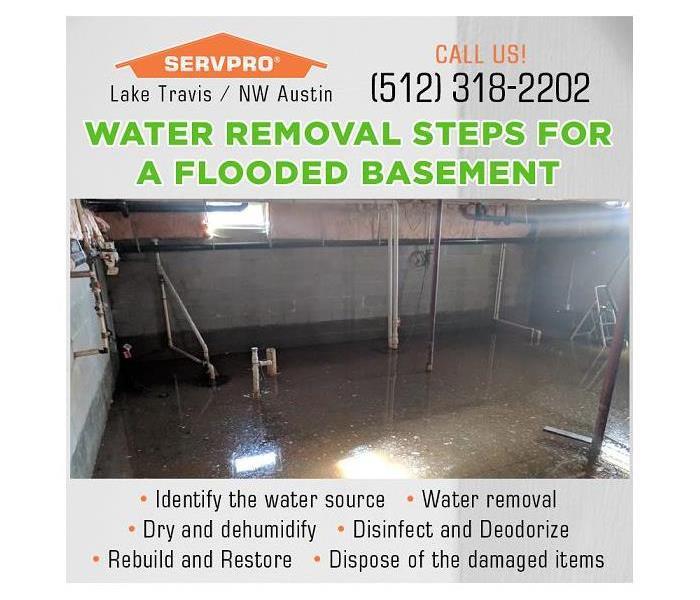Follow the Tips to Clean a Flooded Basement or Call SERVPRO to Take Care of It
7/21/2021 (Permalink)
Blog summary: The SERVPRO article talks about the several steps needed to clean a basement that has been flooded. It also mentions why SERVPRO is one of the best options for helping restore a water-damaged basement.
Tips to clean a flooded basement
A flooded basement can occur during dry or wet weather. Understanding and anticipating the causes of flooded basements helps to create a plan of action for the water removal. SERVPRO, a water damage restoration company, shares below the common causes of flooded basements and steps homeowners can take to clean.
Improper sealing on the flooring and walls
Drainage tile failure
Improperly installed downspouts
Debris in the gutters (eavestroughs)
Water supply line failure (broken, cracked, or clogged pipes)
Hot water tank failure
Sump pump failure
Water removal steps for a flooded basement
- Identify the water source
If there is a leak from a source within the basement, the first step is to shut off the water right away. However, when the basement is flooded due to rain storms or melting snow, the plan of action changes.
SERVPRO’s team can reach an emergency within 24 hours, assess the situation quickly, and begin the process of restoration at the earliest. The complete process from assessment and cleaning to insurance claims can be taken care of by SERVPRO experts.
- Water removal
Limiting the damage due to flooding is a priority. A sump pump is the best way to remove water from the basement. A wet-dry vacuum or a bucket are other alternative options to remove the water. The water must be dumped outside and away from the house foundation to prevent a backup.
A professional company like SERVPRO can remove hundreds or thousands of gallons of water from the property, using powerful pumps and truck-mounted vacuum units. This swift and accurate work protects the property from secondary damage.
- Dispose off the damaged items
Removing items damaged by floodwater is crucial to avoid mold growth, warping, and rot. Items such as carpets and furniture that absorb water easily can usually be salvaged if they are removed from the water before 24 hours. However, irrespective of the swift response, some items may be beyond saving. Carpeting, carpet padding, insulation, electronics, and paper goods are some of the most easily damaged items. Walls and furniture can also be severely impacted by delayed water removal. It is ideal to use heavy-duty plastic bags to throw things away and avoid overloading the bags.
- Dry and dehumidify
Once the water and damaged items are removed, the basement must be dried out. High-volume fans and structural drying dehumidifiers can be used for this purpose. House fans also work but they take much longer to dry, leading to secondary damage such as mold. The baseboards, if any, can be removed and 1-inch holes can be drilled halfway between the wall studs at the base of the walls. This enables moisture to evaporate from behind the walls.
A professional restoration company like SERVPRO uses the latest dehumidification equipment to monitor the drying progress using moisture meters until the materials return to acceptable drying goals.
- Disinfect and Deodorize
Once the basement and its contents are dried, disinfect and deodorize everything. Using bleach is not advised as it can only kill live mold and not mold spores. Household detergent is preferable. It is, however, advised to hire a professional mold remediation company such as SERVPRO to ensure complete removal of mold and prevent its recurrence. To remove odors, sprinkle baking soda around and vacuum it once it has absorbed the odor after a few hours.
SERVPRO uses adequate cleaning techniques to clean and sanitize contents. It also uses industrial-grade air scrubbers and fogging equipment to ensure odors are completely removed.
- Rebuild and Restore
The last step is to rebuild the basement. Make any necessary repairs, such as filling foundation cracks, replacing damaged drywall with a mold-resistant type, and sealing windows and vents. In some cases, painting may be needed. Severe damage may entail purchasing new carpeting or constructing a new drywall.
This is a tedious and complex task, and SERVPRO not only makes minor repairs but also offers a reconstruction of rooms and areas in a home.
A DIY cleaning of the basement is possible in cases of minor flood damage but when the damage is severe, homeowners must opt for a water damage restoration company such as SERVPRO. Why? SERVPRO not only has the expertise and the technology to restore the basement but also enables a smooth insurance claims process.
Why SERVPRO?
- SERVPRO uses state-of-the-art equipment to bring the damaged property back to its original state. SERVPRO of Lake Travis / NW Austin is always updating its fleet and equipment so clients in Lago Vista and surrounding areas can quickly access the services.
- With over 1,700 US and Canadian Franchise locations, SERVPRO is strategically positioned to respond faster to an emergency of any magnitude.
- The SERVPRO staff is highly trained in property damage restoration. They receive initial in-house training and constant skill up-gradation at the corporate training facility and also acquire IICRC-industry certification.
For water damage restoration, call SERVPRO of Lake Travis / NW Austin today at (512) 318-2202.

 24/7 Emergency Service
24/7 Emergency Service
